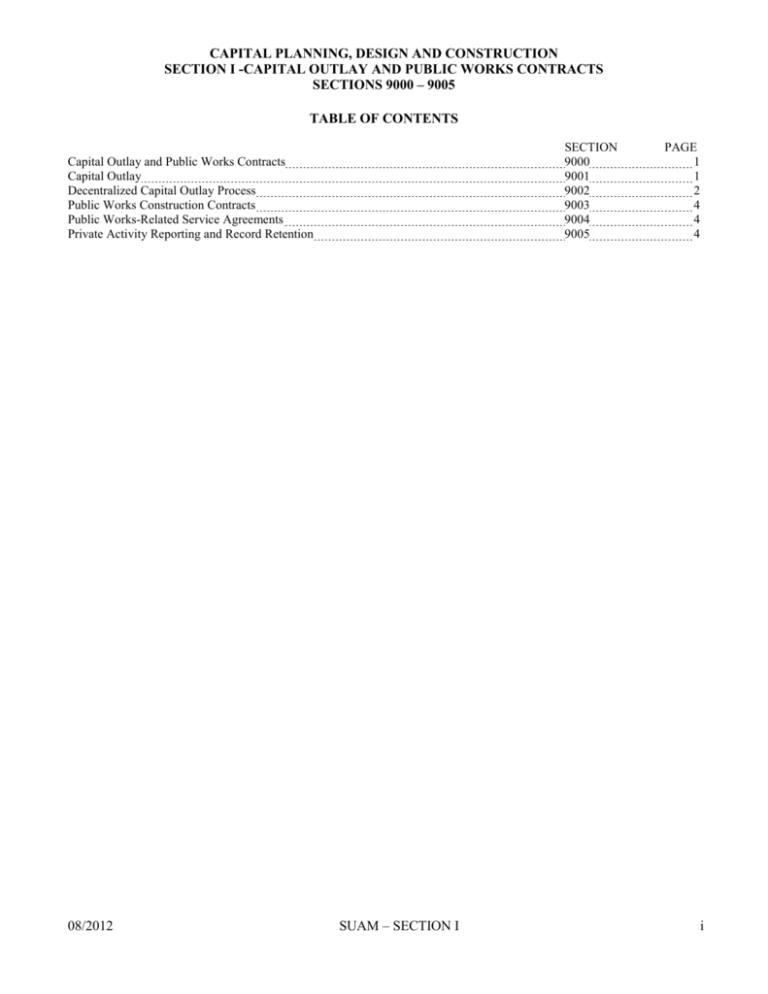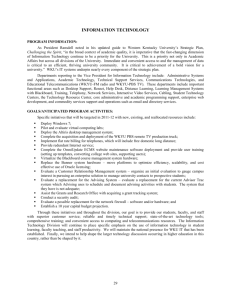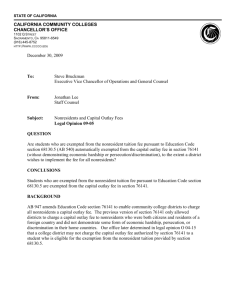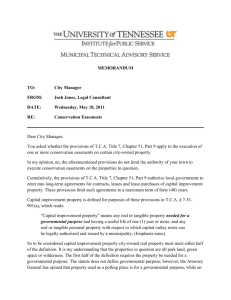SUAM 9000-9004 - CPDC - Capital Outlay and Public Works Contracts
advertisement

CAPITAL PLANNING, DESIGN AND CONSTRUCTION SECTION I -CAPITAL OUTLAY AND PUBLIC WORKS CONTRACTS SECTIONS 9000 – 9005 TABLE OF CONTENTS SECTION 9000 9001 9002 9003 9004 9005 Capital Outlay and Public Works Contracts Capital Outlay Decentralized Capital Outlay Process Public Works Construction Contracts Public Works-Related Service Agreements Private Activity Reporting and Record Retention 08/2012 SUAM – SECTION I PAGE 1 1 2 4 4 4 i CAPITAL PLANNING, DESIGN AND CONSTRUCTION SECTION I -CAPITAL OUTLAY AND PUBLIC WORKS CONTRACTS SECTIONS 9000 – 9005 9000 CAPITAL OUTLAY AND PUBLIC WORKS CONTRACTS 9001 CAPITAL OUTLAY Capital outlay includes purchases of land and costs related thereto, including capital outlay planning and administrative costs, court costs, condemnation costs, legal fees, title fees, etc., and construction projects, including preliminary planning, working drawings, and equipment related to a construction project regardless of cost or timing. Construction projects include new construction, alterations, and additions or betterment of existing structures and infrastructures. Capital outlay budgets are zero-based each year. This means for all new project starts, or subsequent phases of an existing project for which funding is requested, a capital outlay budget change proposal (COBCP) must be submitted to the Department of Finance for inclusion of funding in the Governor’s Budget. The Capital Outlay Program is shaped through a dynamic process that is defined through state laws, policies, and procedures. The California State University (CSU) policies and procedures generally parallel those of the state. Some capital projects may be unique and require special attention outside the established capital outlay process. Major Capital Outlay Capital outlay projects that cost over $610,000 are considered major projects. State site acquisition projects regardless of amount, are funded in major capital outlay. Minor Capital Outlay Minor capital outlay projects are composed of construction projects whose estimated cost is $610,000 or less. The Capital Planning, Design and Construction (CPDC) portion of the State University Administrative Manual (SUAM) provides a reference source of policies and procedures relating to the budgeting, design, and construction of capital outlay projects. These broad categories of the capital outlay process are set forth in this manual in order of the process. It is important that campuses in the CSU continue to develop and maintain an effective and aggressive Capital Outlay Program to keep pace with the student enrollment pressures. Historically the Board of Trustees for the CSU has taken special interest in the physical development and building renewal of each campus because of the long-term visibility of the physical facilities at each campus. The board requires the physical development of each campus to follow the campus master planning objectives; this includes both the Physical Master Plan and the Academic Master Plan. Proper planning, programming, budgeting, and project administration are vital to the capital outlay process. A successful capital outlay program begins with effective program planning and facility management. It is state policy that the justification for all capital outlay projects be based on optimum utilization of existing space and property and documented workload projections. Projects should be carefully conceived and justified to provide cost effective solutions for program delivery. Projects should be professionally designed and managed to ensure against waste in the expenditure of public funds. Specific appropriations of funds are based upon need, scope, phase, estimate of cost, and relevant environmental reviews. Capital financing through state appropriations may take several forms such as: direct appropriations from various general or special fund revenue sources, proceeds of general obligation bonds, lease purchase agreements, lease revenue bonds, revenue bonds, and in some cases certificates of participation issued by the State Public Works Board. Appropriate financing is determined through the legislative process. The Department of Finance (DOF), the State Public Works Board (PWB), the Joint Legislative Budget Committee (JLBC), the Legislative Analyst’s Office (LAO), the Department of General Services (DGS), and other state agencies through powers and duties defined in various sections of the Government Code, all perform key roles in the CSU capital outlay process. By statute, the PWB acquires property for the state. The PWB must approve the preliminary plans for major capital projects prior to allocation of additional funds; exemption from this approval may be delegated by provisional language in the appropriation. The PWB ensures that legislatively approved scope 08/2012 SUAM – SECTION I 1 CAPITAL PLANNING, DESIGN AND CONSTRUCTION SECTION I -CAPITAL OUTLAY AND PUBLIC WORKS CONTRACTS SECTIONS 9000 – 9005 and cost of projects are adhered to. However, the PWB has authority to revise the cost and to modify the scope as granted by statute. Persons in the Department of Finance, Capital Outlay Unit, serve as staff to the PWB for all construction items. The Office of Energy Assessments (OEA) acts as staff to the Board for energy related projects. Persons in the Office of Real Estate and Design Services act as staff to the PWB for all real estate related activities. 9002 DECENTRALIZED CAPITAL OUTLAY PROCESS Reference: Executive Order No. 672 February 1, 1995 The capital outlay process for the California State University was restructured effective fiscal year 1997/98. Executive Order No. 672, delegated capital outlay management authority to campus presidents (July 25, 1997). Beginning with that fiscal year the Chancellor’s Office began receiving funding for two categories of projects, streamlined (302) and non-streamlined (301). Streamlined projects typically receive funding for preliminary plans, working drawings, and construction in one fiscal year and are governed by provisional language in the appropriation. These projects must be submitted to the Board of Trustees for approval of schematics and completion of each subsequent phase must be submitted to CPDC as detailed below. Non-streamlined projects must also submit schematics to the BOT for approval, are governed by Section 2 of the Budget Act, the DOF must approve allocation of funds for each phase, and the PWB must approve preliminary plans. Major restructuring elements included the following: • • • • • • Campus presidents received authority to manage all approved capital outlay projects from initial funding through completion of the project (E. O. No. 672). With delegation, campuses may contract for all services, including construction contracts. CPDC will continue to maintain its policy and budgeting role in the development, processing and administration of the systemwide annual capital outlay program and five-year capital improvement program. CPDC will also provide consultation to campuses on matters of design and construction management. Increased capital outlay financial management authority through a single appropriation and lump-sum funding (preliminary plans, working drawings, construction, and maybe equipment) for each capital outlay project. Approval of alternative project delivery methods. A streamlined professional appointment and project approval process (E.O. No. 666) Program Accountability A process has been established to ensure that campuses that have delegation authority are prepared to manage a complex program. The process consists of four accountability measurements that allow the Chancellor’s office to establish campus eligibility, monitor project development, evaluate performance, and mitigate budget problems through strict financial accountability. The four measurements are: I. Certification of Eligibility Each campus must be certified to qualify for delegation. This is accomplished through a Certification Review Board (CRB). This board reviews and evaluates campus Capital Outlay Management Plans that define the campus organizational, operational structure and expenditure authority. Upon review, the board recommends certification to the executive vice chancellor and chief financial officer of Business and Finance. Updated plans shall be submitted every two years and/or when campus operational structure changes are made which impact the management plan. Certification is continuous unless a post project performance review determines that problems exist due to negligence of the campus in the management of the capital outlay process. The CRB may recommend the campus be placed on probation in order to allow them the opportunity to remedy the operational/management deficiencies. If the review of a subsequent project evaluation indicates these types of problems and board recommended corrective remedies could not be implemented by the campus, the board may recommend to the executive vice chancellor and chief financial officer of Business and Finance that certification be withdrawn. 08/2012 SUAM – SECTION I 2 CAPITAL PLANNING, DESIGN AND CONSTRUCTION SECTION I -CAPITAL OUTLAY AND PUBLIC WORKS CONTRACTS SECTIONS 9000 – 9005 II. Project Development Compliance Campuses that have delegation authority are required to submit the following to their CPDC University Planner: At completion of each phase; schematics, preliminary plans, and working drawings: • • • • • • • A letter certifying project is within scope and budget, including any corrective action required to keep the project within the established scope, budget and schedule A completed Major Capital Projects Transmittal Sheet and all required documentation, by phase Set of Plans and Specifications Architect’s Cost Estimate Room Summary (CPDC 3-1) Current CPDC Form 2-7 and CPDC 2-7.5 signed by the campus Executive Facilities Officer CEQA compliance documentation (schematic phase only) When proceeding to bid: • • • All items listed above, and, If applicable, a list of allowances and/or alternates A statement of Finances Prior to Bid At award of construction contract: • • • • • A complete set of bid documents A completed Major Capital Projects Transmittal Sheet and all required documentation, by phase Abstract of Bids Statement of Finances after Receipt of Bids CPDC Form 2-7 at award signed by the campus Executive Facilities Officer. All required CPDC forms, including the Major Capital Projects Transmittal Sheet, are available at http://www.calstate.edu/cpdc/Facilities_Planning/forms.shtml. A copy of the Transmittal Sheet checklist for each project will be distributed to the vice president with the project allocation notice for campus internal use. The project fund life for encumbrance and liquidation will also be provided with the allocation notice. III. Post Project Performance Review The management of capital outlay projects is reviewed and an evaluation of the outcome is measured against a set of performance criteria. These are intended to identify any management issues that require correction or may be a cause for reconsideration of the delegation authority. The criteria to be used are as follows: • • • • • • 08/2012 Time related to the overall process, and for each phase of the total project cycle. Completeness of project files including all required forms and submittals, as documented by Major Capital Projects Transmittal Sheets and deliverables, by phase. Resources required to complete the project, compared to original budgets, project architect’s estimate, construction estimates, and actual costs. Projects may be compared to similar types for validation of actual cost. Use of any project savings or bid savings. This information will also be posted to the Bond Accountability website as necessary. Changes that are required including number, type and amount of change orders. These should also be expressed as a percent of the construction contract. Change-of-scope items processed and number of addenda processed during bid phase should also be listed. Claims against the project, including the number and amount. Claims should also be expressed as a percent of the construction total. Additionally, this criterion would describe the method used for settlement, i.e., negotiated settlement in construction, Claims Review Board process, mediation, arbitration or litigation. SUAM – SECTION I 3 CAPITAL PLANNING, DESIGN AND CONSTRUCTION SECTION I -CAPITAL OUTLAY AND PUBLIC WORKS CONTRACTS SECTIONS 9000 – 9005 Capital Planning, Design and Construction will conduct the performance reviews for all capital outlay projects. The results will be reviewed with the campus for their comments prior to the final performance review submittal to the Certification Review Board. The level of review for projects will be dependent on the previous review of campus project management. The performance review will be sent to the campus vice president. IV. Financial Accountability Financial accountability for each project must be maintained. Criteria to be used are as follows: • • • • • 9003 Campuses will be required to use every means available to fund excess budget requirements during project development and implementation. This may involve the use of local resources or the elimination of non-essential project elements (value engineering). Augmentations for budget overruns are not available from the State for streamlined projects. Augmentations from local sources should not exceed 10 percent of the project budget. Augmentations for non-state funded projects are the responsibility of the campus and are not restricted to the 10 percent limit of the project budget. Campus participation in the CSU Construction Claims Program is required for all State funded capital outlay projects. Its purpose is to provide a source of funds to resolve construction claims resulting from streamlined projects. The source of funding is one percent of the construction contract value at award. The use of the Claims Program fund is to be considered after all attempts are used to resolve and minimize the claim. Claims should be handled either through negotiated settlements during construction or the Claims Review Board process. CPDC staff will facilitate this process and provide consultation to campuses in order to resolve claims issues and avoid litigation. PUBLIC WORKS CONSTRUCTION CONTRACTS Public works involve the erection, construction, alteration, painting, repair, or improvement of any state structure, building, road, or other state improvement of any kind. SUAM Section XII-9700 et seq. describes the requirements for preparing and administering public works contracts under the authority given the Trustees in the Public Contract Code including those sections, referred to as The California State University (CSU) Contract Law. Campus presidents or their designees have been delegated authority to execute and administer certain public works contracts in conformity with the requirements of the law and CSU policy. 9004 PUBLIC WORKS-RELATED SERVICE AGREEMENTS Under the authority given the Trustees in the Public Contract Code, authority has been delegated to the campuses to develop and administer service contracts in connection with a public works project provided that such contracts, regardless of cost, are reviewed and approved by the Office of General Counsel. This delegation is to be exercised in conformity with the requirements of the law and CSU policy. The procedures for public works-related service agreements are set forth in SUAM Section X.9200 et seq. 9005 PRIVATE ACTIVITY REPORTING AND RECORD RETENTION Campuses are responsible for adherence to reporting guidelines that conform to the State Treasurer’s Office (STO) requirements to demonstrate compliance with IRS tax codes related to private activity use limits for subleased areas and federal research in campus facilities during the life of the tax-exempt bonds funding campus projects. Federal tax law defines the permissible limits of private use in tax exempt bond funded facilities and establishes requirements for record retention practices, typically for a period of 35 years following project completion. Campuses will use report forms (CPDC 4-2, 4-4, Appendix B) to identify IRS “safe-harbors” related to grants/research funding and methods of allocating donor or Non-State reserve contributions towards leased areas in order to fit within permissible limits of private use. Campuses are further responsible for retention of all records related to leased space and research activity funded by private entities, including the federal government, in support 08/2012 SUAM – SECTION I 4 CAPITAL PLANNING, DESIGN AND CONSTRUCTION SECTION I -CAPITAL OUTLAY AND PUBLIC WORKS CONTRACTS SECTIONS 9000 – 9005 of IRS audit procedures. Campuses shall develop a record retention process to obtain, record, and maintain the records of all lease and sublease arrangements, research grants and square footage of areas involved for the duration of the bond life plus five years, typically a total of 35 years. Reporting and records retention requirements associated with these guidelines are described in SUAM section IV, Paragraph 9030.2. Campuses will also update the Space and Facilities Database (SFDB) via the web based reporting system on an annual basis to include appropriate space use change request procedures to capture the potential private activity uses including grants/research and leased area by facility as they may develop over time. Procedures for reporting space use change requests related to private activity use are described in SUAM section V, Paragraph 9047.01. 08/2012 SUAM – SECTION I 5







